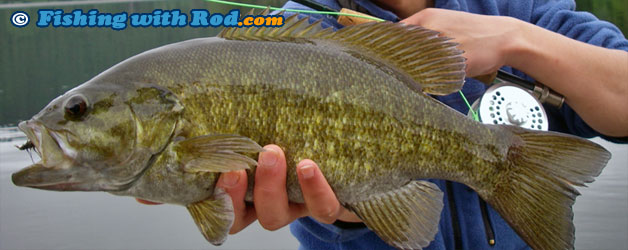Smallmouth Bass
Micropterus dolomieui

A signature species in the sunfish family, smallmouth bass is a popular gamefish in North America. Also commonly known as a "jumper" or "smallie", a smallmouth bass is recognized as a trophy fish by most anglers while an ecological pest when introduced into a new region.
Description
A smallmouth bass can display several different colours, they include tan, brown, bronze or dark green. Distinct vertical stripes can be seen across its body. To distinguish between a smallmouth and a largemouth bass, simply observe their closed mouth. Unlike the largemouth, a smallmouth bass' mouth does not extend further beyond its eyes. A smallmouth bass possesses up to six dorsal spines while its dorsal soft ray number ranges between 13 and 14. Average fish size is between 2 to 4lb, but fish beyond the 10lb mark has been recorded in the past.
Distribution
Smallmouth bass are widely distributed across North America but they are native to the Mississippi River watershed. Due to human introduction, they can be found in the Great Lakes system and most Southern US states. They are also found in numerous watersheds on the West Coast. In British Columbia, they are found in several lakes on Vancouver Island and in the Okanagan region. They have also been introduced in several countries for sportfishing.
Life History
Smallmouth bass inhabit in shallow rocky or weedy areas of lakes, reservoirs and moderate flowing rivers with gravel bottom. Water quality is an essential factor, smallmouth bass prefer clean, clear water. Spawning takes place during spring months. Youngs feed on aquatic insects and plankton while adults prey on small fish and crayfish.
Fishing Locations
There are various lakes across BC where smallmouth bass fishing can be done. In the coastal region, St Mary Lake, Elk Lake, Beaver Lake, Shawnigan Lake are just some of the more popular lakes where smallmouth anglers frequently visit. Other regions include Southern Okanagan and Kootenay regions. When fishing for smallmouth, look for shallow waters that consist of structures such as reeds, logs, and rocks.
Fishing Techniques
A smallmouth bass is not hard to entice as most presentation will work once the fish is located. Topwater crankbait, plastic jigs, spinnerbait are very popular among gear anglers. A simple "worm under the bobber" setup can easily trick a smallmouth as well. Be sure to pay close attention to their diet at the lakes where you are fishing. Size of the bait and lure makes a big difference at times. A 6lb test setup is ideal. A smallmouth bass will also take a fly such as a wooly bugger or leech. When fishing for smallmouth, target areas where smallmouth may possibly inhabit. These areas include shady, weedy waters or areas where many fallen logs or rocks can be found. Fish can be caught both on the surface or subsurface, so be sure to experiment with various techniques until you find where the action is! Smallmouth bass will bite throughout the day, but early morning and late evening remain the time when fish are most active.
